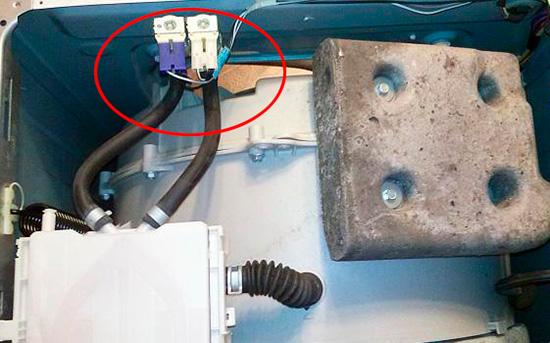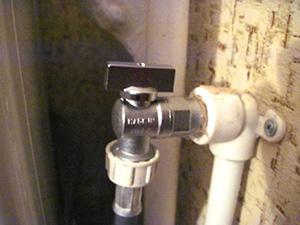Household appliances often "please" us with random failures and breakdowns - no one is immune from this. Automatic washing machines, consisting of many nodes, are also subject to this. If the washing machine draws water in the off state, then this is already a clear sign of a malfunction. If such a breakdown occurs, it is urgent to shut off the water supply in order to avoid flooding the neighbors. In order to recognize and fix malfunctions in time, you can read our reviews, which discuss error codes and their decoding, for example, Daewoo Washing Machine Codes.
Such an unusual malfunction appears very rarely, but it can somewhat frighten the owner of the washing machine. But there is nothing to be afraid of, since the reason is simple and banal - if the switched off washing machine draws water, then this is a clear sign of a malfunction of the water supply solenoid valve.
Broken water supply solenoid valve

The filling valve of the washing machine is located where it should be - immediately at the inlet to the machine, after the inlet pipe. Obeying commands from the control unit, it opens or closes, starting or stopping the supply of water to the tank of the machine.If you listen closely, then at the moment of water supply, we can hear a slight click - this is the solenoid valve.
If the valve breaks, it can jam in two positions:
- In closed - water will not flow into the tank under any circumstances;
- In the open - water will flow continuously, filling the tank to the very brim and leading to the fact that the machine will pour water over the edge.
The principle of operation of the valve is that it opens when electricity is supplied - a simple electromagnet is activated, which opens the damper. As soon as the voltage disappears, the valve snaps into place. That is, if the washing machine is completely disconnected from the mains, then the water supply to the tank is not possible. Therefore, you do not need to grab the plug and socket, if the valve breaks and starts to let water through, this will not help. In this case you just need to turn off the water supply.
How to replace the water inlet valve
If your washing machine is turned off and water is collecting, you need to remove and replace the broken solenoid valve. We will not call the workshop or the service center, as this operation is quite simple and does not require the intervention of specialists (provided that the warranty period has already expired). The most important thing is to find and buy a suitable filling valve.
When starting to replace, you need to turn off the water, pull the plug out of the socket and turn the washing machine with its back side towards you. After that, unscrew the inlet hose and remove the top cover from the device in order to gain access to the valve itself.As we have said, most often it is located directly behind the intake tube.
Having found the valve, you need to unscrew it from its regular place, disconnect the electrical wires and disconnect the hoses. We send the broken valve to the trash can and proceed to the installation of a new valve. By the way, The valves themselves cannot be repaired.. Having connected the hoses to the new valve, we proceed to tighten the clamps holding the hoses. If they are disposable, we take new clamps.After that, we connect the wires without confusing the polarity (remember, but rather take a picture of the position of the wires).

The next step is testing, so do not rush to close the top cover. We connect the machine to the water supply and the mains, run any program, carefully inspect the connected hoses for leaks. If water drips here, then the clamps need to be tightened tighter.
If the new solenoid valve shows reliable and stable operation, we can safely close the top cover and start washing. There is nothing difficult in self-replacement, but we saved several hundred rubles on the call of the master - this money is better spent on something else, for example, on washing powder.
Security measures against such leaks

In the event of a solenoid valve failure, water will be drawn into the tank until it begins to pour onto the floor, flooding the bathroom and neighbors. Therefore, we should protect ourselves from the manifestations of such malfunctions. We cannot foresee a breakdown, but we have the ability install a small crane at the entrance to the car. As soon as the machine has completed the washing cycle, the tap can be closed, thus preventing possible water leakage.
For safety reasons, the faucet is installed directly after cutting into the main pipe - this will help prevent possible leakage in the event of a break in the inlet hose. But you need to remember that the crane should be in the most accessible place. Many people neglect the installation of a faucet, believing that they can do without it. But will these people be able to quickly run to the common tap to completely shut off the water supply to the house or apartment? It is the operational approach that will help us avoid accidental accidents.

Comments
Thanks for the articles! Learned a lot from you.
Thank you! Very accessible and understandable, saved us time and money
and if water passes when the valve is closed, what is the reason?
Lots of useful stuff! From Soul! Only we have a problem, the machine seems to be standing normally, then it suddenly picks up! It turns out the valve is buggy from time to time? Best regards, Sergei.
Good afternoon.
I have a drain connected to the sink. When you turn on the water in the machine, water is drawn through the drain (the gander itself clogged).
Question: is there an exhaust valve (or something), or is it in the order of things?
I have a top-loading machine, since recently, after washing or when they give water (we have water by the clock), not a lot of water enters the drum when the machine is turned off. Water is drawn into about a quarter of the drum and stops. Can you please tell me what it could be and how to fix it?